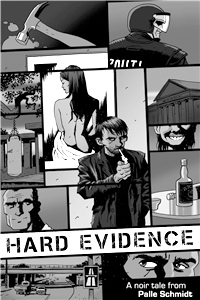
In the year 2000 my friend Malik Hyltoft and I published FUSION the roleplaying game, the first two books from a major Danish publisher and a third was self-published. This was not just a niche product, but a niche within a niche.
I’m super proud of what we put out there, but I found myself wanting to do something something a non-roleplayer could pick up and enjoy. But at the same time, I knew I had something of a fan base in the RPG underground. What to do?
I think it was at some convention a guy showed me a White Wolf comic, based on the Werewolf game, and encouraged me to do something similar with FUSION. I completely dismissed the idea (because I’m an idiot that way). And then changed my mind less than 24 hours later.
The plot for Hard Evidence (in Danish “Skyggen af bevis”) came from a roleplaying game session. Well, two actually. My friend Thomas Bjerregaard came up with the story of a man who seemingly murdered his wife, and a sinister conspiracy beneath it all. First time around, the setting was America in the 1950’s and the investigators FBI agents. I re-hashed the plot for our FUSION campaign, the setting now a near-future Copenhagen and private investigators on the case.
We took turns as game masters in our campaign, like different directors on a tv-show. My character, ex-con Hauge, wasn’t in the session as it played out, but took the stage for the graphic novel. I enjoyed playing this guy so much, I thought he could use his own show. I toned down his thick-headed personality and made him a bit more articulate for the graphic novel. I wanted the dialogue to be zinging and tough, like Raymond Chandler at his best.
In a way, this project was a stepping stone for me. It got me back into comics, when I thought it too hard. The Devil’s Concubine was scripted and thumbnailed and just laid there, like a mountain waiting to be climbed. Hard evidence seemed like a less daunting task. Drawing it got me back into shape and rebuilt my confidence. The story originally ran as a weekly web comic on the FUSION website, thus forcing me get the damn pages done in time. I can highly recommend this method. Only downside is that everyone has read the book before it comes out. I coerced a few of my peers into doing art for a pin-up gallery in the back, so byers would get something new for their money.
Lessons learned:
Sometimes it’s a good idea to do a smaller project, almost like a throw-away thing rather than trying to tackle the most ambitious thing you can think of.
This post is an excerpt from my book SOLO – Survival Guide for Creative Freelancers – Get in now on Amazon.
